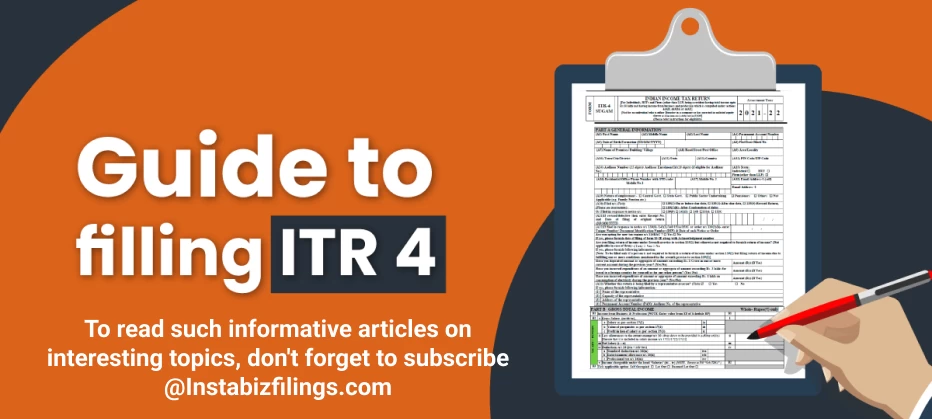
ITR-4 Return Filing
February 17, 2025 by Team Instabizfilings
What is ITR-4? The Income Tax Return (ITR) form 4 is used by taxpayers who are individuals, Hindu Undivided Families (HUFs), and small businesses to file their tax returns in India. It is specifically designed for taxpayers who earn income from business or profession under a presumptive taxation scheme under Section 44AD, 44ADA, or 44AE of the Income Tax Act.
Who Should File ITR-4?
ITR-4 is intended for individuals and HUFs who meet the following criteria:
-
Presumptive Income:
- The person is earning business income under Section 44AD (for small businesses with income up to ₹2 crore), Section 44AE (for income from the business of plying, hiring, or leasing goods carriages), or Section 44ADA (for professionals like doctors, lawyers, etc.).
- These presumptive schemes simplify income reporting and tax filing by providing a fixed percentage of income as taxable.
-
Income from Business or Profession:
- For taxpayers earning income through business or profession and opting for the presumptive taxation scheme.
-
Income from Salary/Pension, House Property, or Other Sources:
- If you are a salaried individual and have income from business under the presumptive scheme, ITR-4 is applicable.
-
No Income from Capital Gains:
-
No Carry Forward of Losses:
- If you have losses to carry forward from business, you cannot file ITR-4. In such cases, ITR-3 should be filed.
Eligibility for Presumptive Taxation Scheme (Section 44AD, 44AE, 44ADA)
-
Section 44AD (Presumptive income for small businesses):
- For individuals or HUFs with a turnover up to ₹2 crore.
- 8% of the total turnover or receipts is deemed as income, or 6% for digital payments.
-
Section 44AE (Presumptive income for businesses in goods carriage):
- For businesses engaged in the business of plying, hiring, or leasing goods carriages.
- Presumed income is based on the number of vehicles owned and operated.
-
Section 44ADA (Presumptive income for professionals):
- For professionals like doctors, lawyers, engineers, etc., with gross receipts up to ₹50 lakhs.
- 50% of the total gross receipts is considered as the presumptive income.
Documents Required for Filing ITR-4
Before you file ITR-4, make sure you have the following documents handy:
-
PAN Card: Personal identification for tax purposes.
-
Aadhar Card: For linking with the PAN (mandatory).
-
Bank Account Details: Bank statements for verifying income and tax credits.
-
Form 16: Issued by the employer for salaried individuals (if applicable).
-
Balance Sheet: If applicable, for businesses opting for other methods of accounting.
-
Details of Business Income: For those filing under presumptive taxation.
-
Tax Paid: Tax receipts and challans if advance tax or self-assessment tax has been paid.
-
Other Income Details: Any income earned from investments, savings accounts, or other sources.
Steps to File ITR-4
Here’s a step-by-step guide to filing ITR-4 online:
- Step 1: Visit the Income Tax Portal
-
You must access the official Income Tax e-filing portal through your internet browser.
- Step 2: Register or Login
-
Users who do not have an account should use their PAN to make a new profile. The login process will be easy for registered users to access their account through their authentication details.
- Step 3: Select the ITR Form
-
Once logged in, click on ‘File Income Tax Return’.
-
Select ITR-4 as the form for filing.
- Step 4: Choose the Assessment Year
-
Ensure you are selecting the correct assessment year for which you are filing.
- Step 5: Fill in the Details
-
Fill in personal details such as name, address, PAN, and contact information.
-
Input details about income under Presumptive Taxation Scheme (Sections 44AD, 44AE, or 44ADA).
- Step 6: Provide Income Details
-
Report your income from business or profession. If you are claiming presumptive income under Section 44AD, input the total turnover and ensure the correct percentage of income is calculated.
- Step 7: Tax Calculation and Tax Paid
-
The portal will automatically calculate your tax based on the income entered.
-
Input details of advance tax, TDS (Tax Deducted at Source), or self-assessment tax paid.
- Step 8: Verify and Submit
-
Review all the details entered for accuracy.
-
Once verified, submit the form electronically.
- Step 9: E-Verify the Return
-
After submitting the return, verify it using one of the available methods (Aadhar Card OTP, Net Banking, or by sending a signed copy of ITR-V to the Income Tax Department).
Benefits of Filing ITR-4
-
Simplified Tax Filing: Small businesses and professional taxpayers under presumptive tax requirements use ITR-4 as their simplified tax filing form.
-
Presumptive Taxation Benefits: Business owners can forego complex accounting responsibilities as their income gets determined with easy calculations of recorded transactions.
-
Faster Refund Processing: Using an online filing method speeds up the processing of tax refunds when applicable to taxpayers.
-
Avoid Penalty: The prompt filing of ITR-4 helps you steer clear from payment penalties because of delayed submission.
-
Tax Credit Carry Forward: The system enables loss transfer with specific restrictions however it does not permit business loss transfer under ITR-4.
Common Mistakes to Avoid While Filing ITR-4
-
Incorrect Income Reporting: Ensure that all income from your business or profession is reported accurately, especially if you are opting for presumptive taxation.
-
Failure to Verify the Return: After submission, remember to verify your ITR. If you don't verify it, the return will be invalid.
-
Incorrect Selection of ITR Form: If your income includes capital gains or income from other sources, don’t file ITR-4; use ITR-2 or ITR-3 instead.
-
Missing Tax Deductions: Don’t forget to claim any deductions under sections like 80C, 80D, etc., if applicable.
Deadline for Filing ITR-4
-
Individuals need to file their ITR-4 through the specified deadline which falls on 31st July until the Income Tax Department extends it.
Conclusion
Making ITR-4 submissions serves as an essential requirement for taxpayers who must adhere to Indian tax guidelines. A clear grasp of the tax return process together with all necessary documents and eligibility criteria enables users to file their statements timely thereby obtaining maximum tax advantages while following tax regulations. Regular updates to your records should always be maintained while consulting tax professionals when needed to prevent filing errors.
Disclaimer
The information provided in this blog is purely for general informational purposes only. While every effort has been made to ensure the accuracy, reliability and completeness of the content presented, we make no representations or warranties of any kind, express or implied, for the same.
We expressly disclaim any and all liability for any loss, damage or injury arising from or in connection with the use of or reliance on this information. This includes, but is not limited to, any direct, indirect, incidental, consequential or punitive damage.
Further, we reserve the right to make changes to the content at any time without prior notice. For specific advice tailored to your situation, we request you to get in touch with us.


